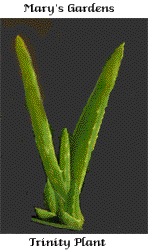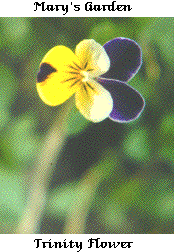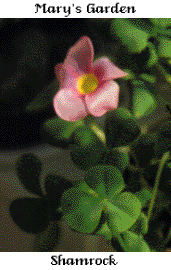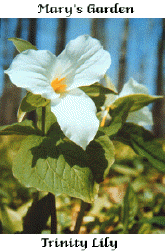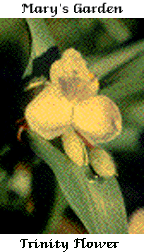John Stokes and Mary's Gardens
Flowers of the Trinity
Flower and Human Symbols of the Trinity
– John S. Stokes Jr.
In undertaking our acts and works we bless ourselves, making the Sign of the Cross, "In the name of the Father and of the Son and of the Holy Spirit", to quicken our awareness and love of the one God, the Blessed Trinity, as the beginning, ground and end of our being for all eternity; and to offer our acts and works, and also our sufferings, for the spiritual intentions of the Trinity - for Creation, Redemption and Kingdom.
We do this rejoicing that, in the state of grace of our baptism, the undertaking of our acts, works and sufferings for spiritual intentions meritoriously generates further grace, light, wisdom and power rising to the heavenly reservoirs and storehouses, from which, together with those from the acts and sufferings of Christ and the saints, and from all Masses throughout the world, they are distributed through Mary's mediation and the sacramental blessings and indulgences of Holy Church to where most needed in the divine economy for love, sustenance, protection, forgiveness, healing, justice and peace. It is our faith that in this way all our daily acts, works and sufferings, undertaken for spiritual intentions, contribute to the conversion of souls, the healing of bodies, the renewal of the world and the building of God's Kingdom.
In the Mary Garden, sacramentally blest flower and plant symbols of the Trinity quicken the offering of our acts, works and sufferings to the Father, Son and Holy Spirit for spiritual intentions, and recall us to these intentions if we become distracted.
The most familiar of such symbols is that of the Irish shamrock, Oxalis acetosella, with its three-lobed leaves, which St. Patrick pointed out to the pre-Christian Celts of Ireland as a symbol or signature of the true Trinitarian God of whom he preached to them, and in whose name he blessed nature to sanctify it - liberating and protecting it from the power of the false Celtic nature gods worshipped in Ireland prior to his coming there as missionary of Christianity.
With St. Patrick we pray ("The Breastplate of St. Patrick"):
"I bind to myself today
The strong virtue of the Invocation of the Trinity:
I believe the Trinity in the Unity
The Creator of the Universe. . . ."
Other plants bearing the Trinity symbolism, from their three-petaled flowers, include Virginia spiderwort, Tradescantia viginiana, known in Germany as Trinity Flower; and Wake Robin, Trillium grandiflorum, a north-eastern and north-western U.S. wild flower known as Trinity Lily. Their beauty, purity and growth show forth and share the goodness of the One God, and we perceive their tripartite forms as symbols of the revealed truth of the Trinity - much as Adam was instructed to name the flowers of Eden.
In Europe the wild pansy, or johnny-jump-up, viola tricolor, was also widely known as Trinity Flower - for the three colors of each of its flowers, from which familiar present-day larger pansies blooms have been bred with one or two colors usually dominant.
An interesting aspect of bred pansy strains of a dominant color is that the other two colors are always preserved at the centers of the blooms. Thus, pansies of yellow dominance may be seen to symbolize the glory of the heavenly Father; purple the sorrows of the incarnate Son; and white the light of the processing Holy Spirit - with the other colors in each instance always retained at the center, serving to remind us that whenever one of the Persons of the Trinity is present the others are present also, in the unity of the Godhead of love.
Pansies also bear the old name of Our Lady's Delight, whereby, mindful of their Trinity symbolism, we refer to Mary's words, "My spirit has rejoiced in God, my Savior."
As distinct from the shamrock, spiderwort, trillium and pansy - symbolizing the Trinity through their distinct three-fold forms or colors - the burn plant, Aloe vera, has been seen as a Trinity symbol from the characteristic successive emergence of new foliage spears from the base of young plants in groups of three - first two beginning spears, and then a third one between them - recalling the eternal engendering of the Holy Spirit by the Father and the Son in the interior of the Trinity.
The growth symbolism of Aloe vera serves to raise our contemplation to the interior relationships of the three divine persons of the Trinity - the eternal generation of the Son, in love, by the Father; the return of love by the Son to the Father; and the ever-intensification of the communion of love between the Father and the Son, engendering the third divine person, the Holy Spirit. It is thus that "God is love" - the procreative love of God the Father begetting God the Son; the Son's return of that love in communion with the Father; and the co-creative engendering of God the Holy Spirit of love through the ever-intensifying love between the Father and the Son.
Desiring to share itself further, God's love, generated in the furnace of love of the interior of the Trinity, bursts forth eternally in laser-like procession of the Holy Spirit from the Father through the Son, though whom all things were made, creating and fashioning the external heaven and earth to show forth and share the divine goodness, beauty, truth, being and action with humans, created to that end in the divine image and likeness, male and female.
The love of the One God is thus manifested interiorly through the communion of the three Divine Persons, and exteriorly through the creation of the world for the sharing of the divine goodness, creativity and redemption in loving communion with humans - for all eternity.
From our joy in beholding the goodness, beauty and truth of Creation, the grace of Baptism raises our hearts in loving thanksgiving, adoration and rapture to the creating God the Father - with whom we enter into loving communion, and in gratitude consecrate ourselves totally to the building of the earthly Peaceable Kingdom, through the redemption of the Son and the inspiration and prompting of the Holy Spirit, as the culmination of Creation for return to the Father in love, glorified.
Entering, further, into loving communion with Jesus, God the Son Incarnate, we join with Him, as He has joined with us, in the bearing of all our adversities, diminishments and sufferings, which, together with those of all the world, past present and future, He, as divine scapegoat, has taken upon Himself in love on the Cross. With the death of His body they are expiated into nothingness - thus redeeming and freeing the world for the building of the Peaceable Kingdom in grace for its return, glorified, to the Father on the Last Day, in thanksgiving and love, transformed into the eternal New Heaven and New Earth.
Finally, in loving communion with the Holy Spirit, Who indwells with us as His temples, we undertake all our actions, with his inspiration and guidance, under Providence, that our works may be most fully directed towards earthly renewal and Kingdom. We open ourselves to and sustain this communion with the Holy Spirit in the Mary Garden by meditating on and emulating the life and mysteries of Mary, whom He overshadows, in whom He dwells, and whom he has espoused - as beautifully symbolized for our reflection by the Flowers of Our Lady.
Looking then at the whole world as mirror and symbol of the Divinity, we see all fertilization, conception and birth in nature as a mirroring of the engendering of the Holy Spirit by the Father and the Son in the interior of the Trinity. The several series of "Nature", "National Geographic" and other programs on PBS TV have marvelously documented the sublime interaction of birds, bees, other insects, wind and water with the forms, colors, fragrances and bloom times of flowers for their pollination - all in beautiful celebration of the love and fruitfulness of the Trinity. As we behold these wondrous symbols of the divine love we commune spiritually with the Trinity in heightened loving awe and rapture.
In our daily lives we commune with the Persons of the Trinity first of all through our direct, immediate sensory experience of the goodness, beauty and truth of the creatures of Creation - created by God that we may experience and share the Divine goodness, beauty and truth they show forth and share.
An inspirational example of this is the custom from the Caribbean of peeling banana skins in four sections, praying, "In the name of the Father, and of the Son, and of the Holy Spirit, Amen" - bringing us to reflect on the Trinity more fully than we may when we all too often make the Sign of the Cross automatically and unreflectingly.
Giving thanks and praise to God, and mindful of St. Francis, apostle of the Love of God in every creature, we then taste the banana - communing in rapture with the creating God the Father, as we recall the scriptural exhortation, "Taste, and see how sweet is the Lord" - fulfilling even in this small way the purpose of Creation by sharing in its manifestation for us of the goodness of our loving God, among the infinitude of whose attributes is ever "banana". In grateful love and return we heighten our commitment, resolve, prayers and works, as instruments of God's Providence to feed the hungry.
Our heart thus raised in rapture, we likewise taste our cereal, egg, muffin and coffee. In tasting the muffin we give thanks, further, for its exemplification of the refining, blending and cooking of God's creatures - flour, butter, sugar and berries - and for the divinely endowed human capacity for co-creatively "dressing" Creation in the further discovery, showing forth and sharing of God's goodness and wisdom.
After our breakfast - continuing our spiritual communion with the persons of the Trinity - we then set about our day, offering and directing our prayers, acts, works and sufferings redemptively and renewingly towards the conservation, building and coming of God's earthly paradise and kingdom. In this we continue in our openness to and waiting on the inspiration and prompting of God, the Holy Spirit, that, in union with God the Son, we may contribute to the transfiguration of Creation for its return glorified to God the Father on the Last Day in thanksgiving, praise and adoration, for all eternity. In working and praying to this end we are ever mindful, as well, of the present injustices of the plantation economies, migrant workers and other contributors to our breakfast and life which cry out to be transformed in the to-be-worked-for truth, justice, love and freedom of the Peaceable Kingdom.
Entering the Mary Garden thus spiritually attuned, and beholding there the overall light, grace, fragrance and signatures of the flowers, trees, shrubs, vines and grasses of Our Lady - showing forth and sharing, as direct creations of God, the divine goodness, beauty, truth and love - our hearts are raised to God in thanksgiving, praise and love, as we pray the Mary Garden Prayer.
Considering these flower and plant symbols of the Trinity, we then reflect on how the love of the Persons of the Trinity is mirrored, shared and celebrated most sublimely in the relationships of humans, created, according to the Genesis story of the Creation, "in the divine image and likeness, male and female" - from which we are to understand that man and woman together, in love, conceiving and giving birth to a new person, symbolize in the world the eternal generation of the three Divine Persons in the interior of the Most Holy Trinity.
Perceiving their respective spiritual, intellectual, aesthetical, emotional, social and physical endowments with, and their developments of, God's goodness, men and women are attracted to one another, and, through the Sacrament of Holy Matrimony, enter into loving bonding and communion, consummating in marriage of sexual intimacy and union engendering mutual support, creativity and the birth or adoption of a child or children for nurturing within the compass of their love - along with their other creative outpouring beautifully sharing in and mirroring the engendering of the Divine Person of the Holy Spirit in the Heaven of the Trinity.
As this marital communion of love, mutual support, creativity and nurturing by man and woman is sustained and grows in the fallen world, it is enlarged, through the Sacrament of Holy Communion, to include also their mutual acceptance, sharing and offering of encountered unremediable adversities, diminishments and sufferings in the tenderness of loving communion with the incarnate Son of God's bearing of them, and those of all the world, in his redemptive sacrifice on the Cross.
And as marriage partners grow and change in their interests, skills, work opportunities, careers, associations and activities, these, too, are composed within their marital communion of love through the inspiration and promptings of God the Holy Spirit and the graces of the Sacraments of Confirmation and Reconciliation, as we all are guided within unity towards the building of the Peaceable Kingdom.
While the marriage of men and women has been created and blessed by God as the primary means of sharing and showing forth in love the mystery of the Trinity on earth, "there is no marrying or being married in heaven" and it is not marriage itself, but the associated spiritual communion between persons, in loving communion with the Persons of the Trinity, that is the ultimate creative fulfillment of God's purpose in Creation - culminating in the spiritual Communion of Saints in the love of the Trinity in the New Heaven and New Earth for all eternity.
Thus, there are multiple earthly communions variously mirroring the eternal communion of heaven: first of all the spiritual bonding of mother love; and then the spiritual love of siblings, relatives, friends, neighbors, comrades, co-workers, associates and members of societies. There is the special spiritual communion with others which arises from the works of mercy, mission and social justice. The celibate priesthood enters into a special bond and communion with Christ through the Sacrament of Holy Orders for the celebration of Mass and the administration of the sacraments; and there is the ultimate vocation of those who follow the asceti/mystical path to direct union and spiritual marriage with God through the religious vows of poverty, chastity and obedience. In each of these bondings there is a shared communion of appreciation, suffering and creativity - mirroring that of marriage and of the Trinity. Created in the image and likeness of the Trinity, we yearn "to love and to be loved in return", and to express our love in concrete fruits and acts.
The most sublime human loving bond and communion with the divine - achieving and exemplifying to the fullest the potential of our human nature, created in the divine image and likeness, for sharing in the divine goodness and action, in the highest fulfillment of the divine purpose of the Creation - is that of the Blessed Virgin Mary, in her faithfulness to the graces of her Immaculate Conception and her full acceptance of the divine privileges and prerogatives to which she was called at the Annunciation.
First there is her bond with God, the Holy Spirit, Who overshadowed her; Who as her spirit dwelt in her as His Spiritual Vessel and Temple and, as it were, His earthly body; who in loving spiritual communion espoused her, conceiving Jesus to whom she gave birth as the Son of the Most High God; and who, through her supplication and mediation, pours out pentecostally - sanctifying and guiding the Church towards holiness and Kingdom.
Then there is the special bond and communion of Mary with God the Father - as daughter; as companion with Him mystically at the Creation; and as the Mother of God - co-parent with Him of Jesus, true God and true man, the Divine Word Incarnate.
And through her loving bond and communion with Jesus in bridal motherhood - as mother and spiritual companion - Mary has exercised and exercises the divine prerogatives and privileges of intimate union and close cooperation with Him as co-redemptrix at the foot of the Cross, and, after his Resurrection and Ascension, and her Assumption, as our spiritual mother, advocate, intercessor and mediatrix, and as Queen of Heaven and Earth.
Upon her Assumption body and soul into heaven, Mary entered eternally into the interior of the Heaven of the Trinity, from which she emerges as the Woman with Child, Clothed with the Sun - "coming forth as the morning rising, fair as the moon, bright as the sun, and terrible as an army set in battle array."
Each time we turn to Mary in prayer for her loving exercise of her divine prerogatives for us and the world we afford a further opportunity for the Trinity's sharing of the divine action with her, in her ever more sublime fulfillment of the purpose of Creation of divine/human sharing, communion and fruitfulness in love.
In this, our prayers of the Rosary, and all our recourses to Mary in reflection and prayer, are not just meditations and petitions - "that by meditating on her mysteries we may imitate what they contain and obtain what they promise" - but are now an entering into communion with her in respect to both her life and mysteries, and to the present situation of the world and our lives, as we and the world move towards kingdom and heaven.
In this communion we join with her instrumentally in the fruitfulness of her privileged communion, as our Spiritual Mother and Queen, with the Father, Son and Holy Spirit: for the distribution of the divine grace, light, wisdom and power - and of the merits of our own prayers, acts and works, added to those of Christ, herself and the saints - to the world, for Creation, Redemption, Conversion, Repentance, Sanctification, Healing, Reconciliation and Kingdom, as we pray, with St. Louis de Montfort:
"Blessed Mother, use me today."
"Glory be to the Father and to the Son and to the Holy Spirit,
As it was in the beginning, is now, and ever shall be,
World without End. Amen."
From this culmination of our reflections we then return in the Mary Garden to simple contemplation of the flower symbols of the Trinity.
Copyright, Mary's Gardens, 1999
The John Stokes and Mary's Garden collection was transferred to the Marian Library in May 2013. In addition to his archives, manuscripts, artwork, and personal library, John S. Stokes also donated his extensive website. It was transferred to the Marian Library in early 2010. This particular entry is archived content original to Stokes' Mary's Gardens website. It is possible that some text, hyperlinks, etc. are outdated.
